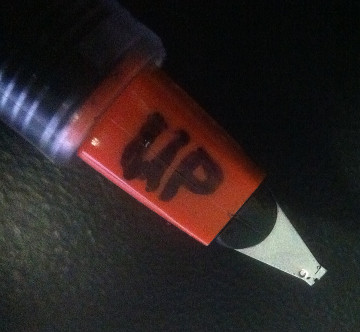
[January, 2016.]
A few years ago, my friend Gale Fagan gave me a set of Pilot Parallel Pens. These are too cool for words; check the Pilot site.
I promptly modified the narrowest of them (1.5mm) to fit my hand:
(Please ignore the three little splotches of ink on the point. Hazard of the trade.)
The angle I put on this nib [I use a gray or purple or white ceramic integrated circuit package to grind the nib to shape, and a brown ceramic package to polish it so it doesn’t dig into the paper] is subtle, and may be hard to see; because my hand position is nearly a mirror image of a typical right-hander’s position, it is about the reverse of a typical nib angle.
I will note, btw, that Pilot makes a converter that fits this pen, and that I got one for it. I loathe disposable things, so I avoid cartridges.
As you can see from Pilot’s page about these, they are art pens, fairly obviously intended for studio use, and they don’t go into a shirt pocket. I don’t have a calligraphy studio, and if I’m going to use a pen it has to be on my person, so I have wanted to put at least this one into a barrel with a clip. (I considered modifying the existing barrel, but that looked like it would be difficult and possibly prone to failure.)
Last November I was able to acquire an empty housing from a rollerball, which has the right size of internal thread to take the “guts” of the Parallel Pen. Unfortunately, the cap wasn’t quite long enough. My initial plan was to slice it into two pieces and lengthen it, possibly with a piece of brass tubing; but it is slightly tapered, so that would probably be fraught, not to mention the fact that it would almost certainly be unaesthetic. A few days ago, after I finally managed to get the housing and the pen into the same place at the same time (don’t ask), it occurred to me that I might be able to get away with drilling a hole in the top end of the cap, letting the point protrude, and putting a dome of some sort over it to keep the pen from drying out. I checked the fit, and was happily surprised to discover that with the body fully assembled, the point would only just about reach the top surface of the cap, so all I really needed to do was cover the hole.
I drilled out the insert [gray object in the photo below] and the cap, checked the fit, and found that the inside diameter of the insert was a bit too narrow: the nose of the pen couldn’t go into it, and so the cap still wouldn’t go on. It is threaded, and is an integral part of the structure, so I couldn’t just pitch it; I ended up using a jeweler’s saw to remove about half of it. Here are the pieces of the cap after I made the modifications:
I wanted something, preferably someting very slightly convex, to cover the hole in the top of the cap, so I looked around. I’m at my mom’s place; it turns out that she has a bunch of thumbtacks, including some yellow ones that are fairly well matched to the color of the barrel and cap. I couldn’t ask for anything better for the purpose. I removed the pin from one of them, and used CA [I have become fond of the “Gorilla Glue” version, which seems to be very good about not clotting inside the applicator], to attach it to the cap. Here is the finished object:
[[I shouldn’t even say it, but this is probably the only Parker Pilot Parallel Pen in existence today.]]
As to the dirt on the thumbtack... sigh. It stuck to my fingers several times before I could get it to stick to the plastic. Such is life in the Cyanoacrylate lane, altogether too frequently. I should probably try to remember the nitrile gloves that I keep on hand for when I’m processing holograms or doing sterile culture of plants or fungi. Dirt to the contrary notwithstanding, I am extremely pleased.
Side note: modifying the widest nib [6 mm] may be an interesting challenge. You can see, in the photo at the top, a little dimple in the metal. There are, fairly obviously, two of these; they set the spacing between the parallels. If I obliterate one of them in the course of changing the nib angle I will need to replace it with something that is fairly precisely the same thickness. That shim, and whatever glue I use to hold it in place (if I use glue, which is likely), must not dissolve in or corrupt the ink.
[Addendum, 2k16-0118]
The pen fell out of my shirt pocket twice yesterday, so I checked and discovered that it was longer than my other pens. Jeweler’s saw to the rescue again; here’s what it looked like after I took about half an inch off the bottom end, just before I glued a second thumbtack to it. There was plenty of room, so I didn’t bother to remove the point from the tack.
As
Michele Macomber
points out, this is clearly a tack hack. [Ahem.]
For contact information, please see the index.
Last modified: Mon Jan 18 16:38:23 EST 2016